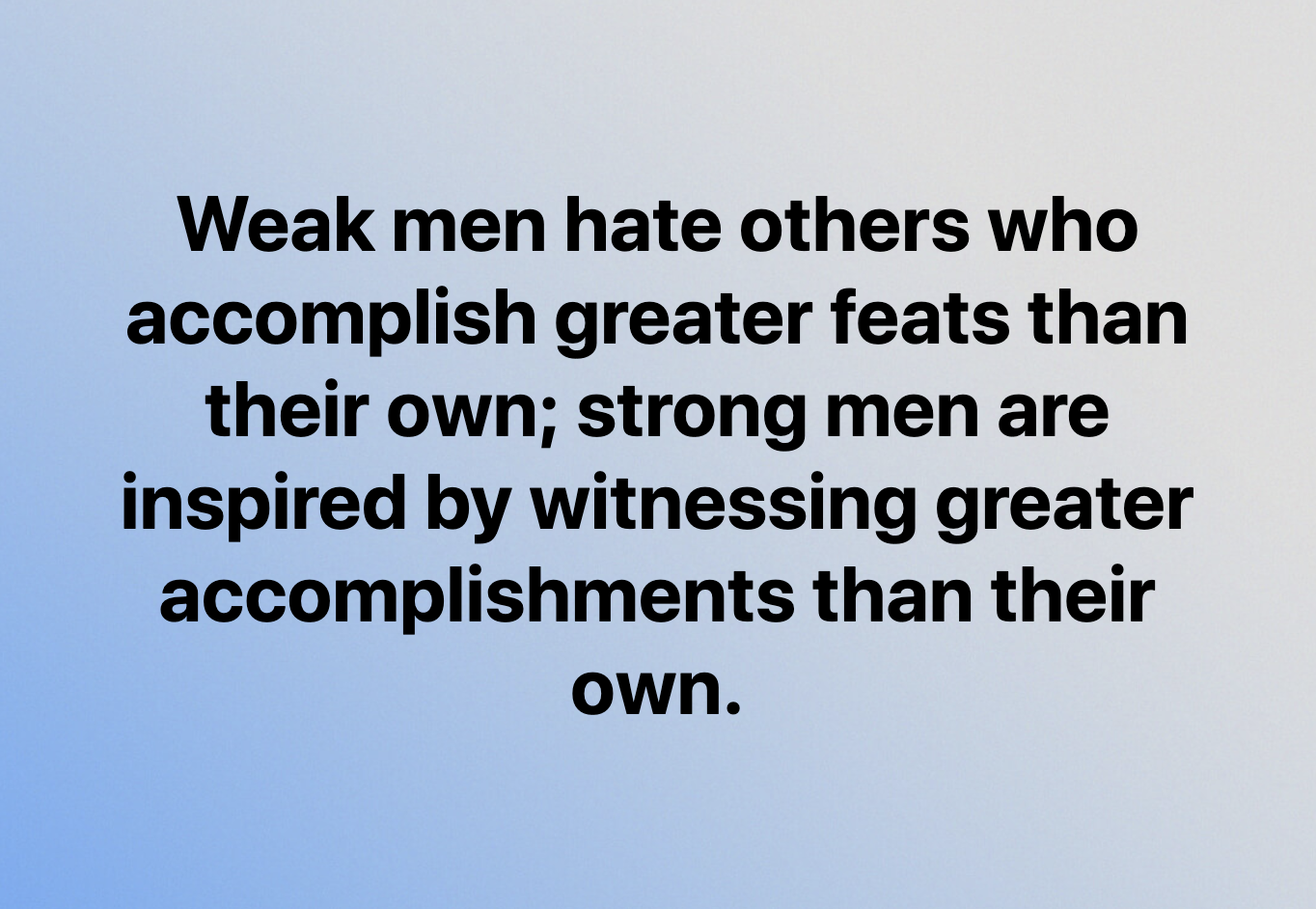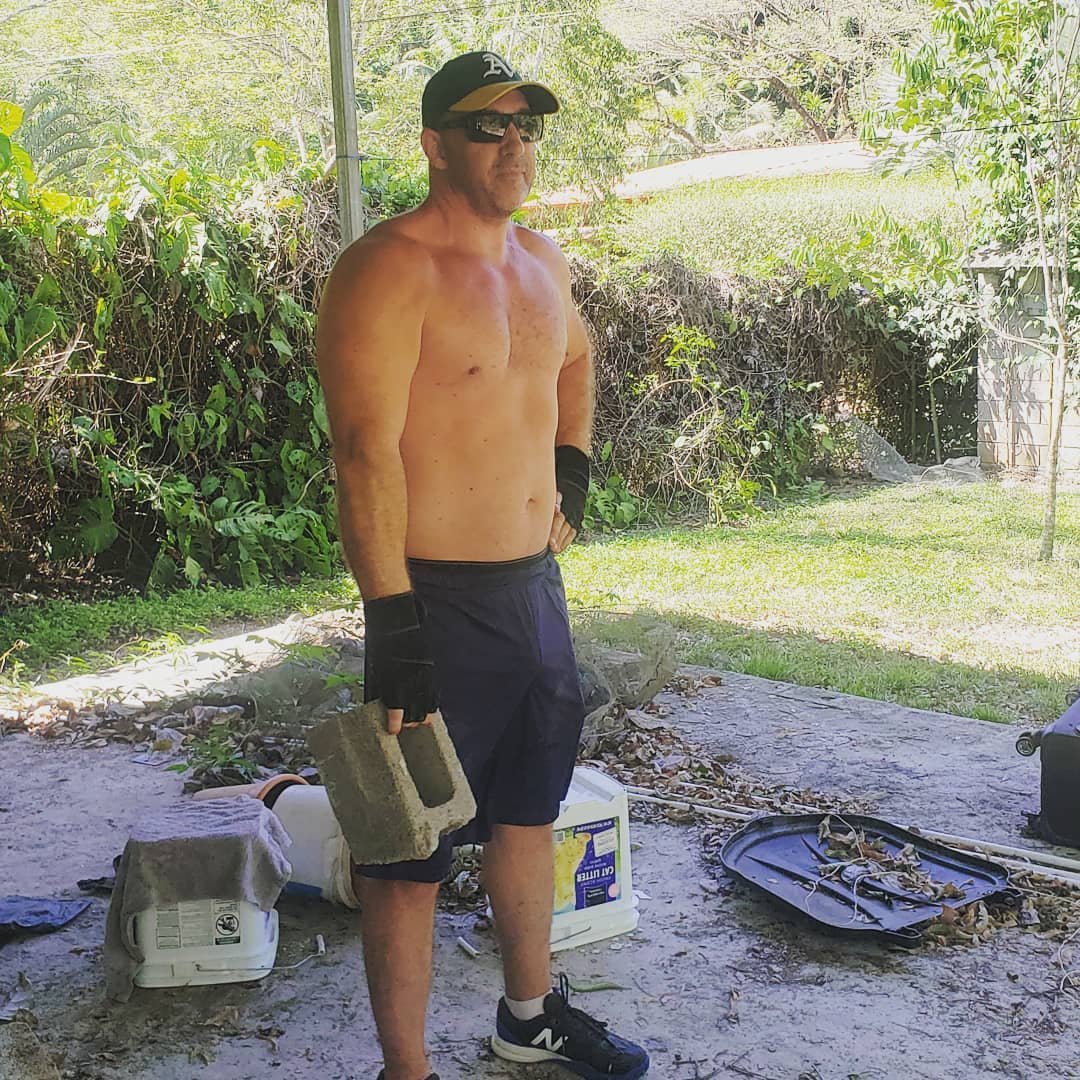Category: Uncategorized Page 2 of 3
“Weak men hate others who accomplish greater feats than their own; strong men are inspired by witnessing greater accomplishments than their own.”

“No weights with gym closed? Create your own with items you find at home like cement blocks.”
Kurt Haskell during the coronavirus ordeal:

So true! There are so many exceptions to the rules, and words are adopted from different European languages.
– –

“Don’t live out of fear. Instead, live out of love!”
Historian James Perloff says he hasn’t done many podcast appearances or blogging lately because “I’m working on a book on 9/11, and I’m finding the only way to get this book done is that you almost have to become a hermit.” – 0:55 of hour 2
The heart is more than a pump, containing brain-like cells. Many emotions and decisions come from the heart, not the brain. So NEVER get a heart transplant!
It’s pretty easy to tell which type I am. How about you?
– –
Head-locators are categorized differently than heart-locators. Head-locators make decisions based on logic and facts whereas heart-locators make decisions based on their emotions. Do you think from your head or your heart?
Dr. Berg explains why many people are too alkaline, not too acidic, as is commonly taught.
Minutes to Midnight (2007) – Album #3
– –
Making Of Minutes To Midnight Subtitulado (HD)
© 2007 Warner Bros. Records Inc., A Warner Music Group Company
Todos los secretos, todo el proceso y el cambio de la banda en este tercer álbum de estudio, titulado “Minutes To Midnight”
Linkin Park Documentary – (Hybrid Theory through Living Things)
RIP Chester…Linkin Park has been my favorite band since 6th grade when Hybrid Theory was the first album I’d ever purchased. In my final semester of college I decided to take an independent study course and produced this video as a tribute. The video discusses the band’s growth from their early years of “Hybrid Theory” through their most recent album “Living Things.” My inspiration came from the deep respect and appreciation I have for the band and their music. Their fearlessness to experiment and grow as musicians regardless of the consequences is a testament to their brilliance.
Meteora (2003) – Album #2
– –
While admiring from Anchorage’s Coastal Trail the s-curves of a waterway that flows into Cook Inlet, I asked a nearby bicyclist if he knew more about this. Did he ever!
Bob told me how he personally tracked the little known, Fish Creek to its headwaters and documented its fascinating journey that is often hidden. He sent me the links to his meticulous research, and gave me permission to share.
One of the problems with ebooks…
Also, I’ve heard Kindle can change the content or delete ebooks even after they’re downloaded.
And books can be highlighted and written on.

Why we’re getting jacked:
– –
From: nbcbayarea.com
‘Patch and Pray’ Crack Repairs on Oroville Dam Emergency Spillway: UC Berkeley Civil Engineer
“They put cement into the cracks and troweled it over,” a Berkeley civil engineer said. “I call it ‘patch and pray”’
Six months before rushing water ripped a huge hole in a channel that drains a Northern California reservoir, state inspectors said the concrete spillway was sound. As officials puzzle through how to repair Oroville Dam spillway, federal regulators have ordered the state to figure out what went wrong.
Earlier inspection reports offer potential clues, including cracks on the spillway surface that if not properly repaired could let water tear through the concrete. In recent years, construction crews patched cracks — including in the area where water burrowed a huge pit last week. …
Last August, a team of inspectors did not check the channel on foot but instead from afar, also concluding that everything looked fine. …
Robert Bea, professor emeritus of civil and environmental engineering at University of California, Berkeley, said it’s “obvious those repairs didn’t work.”
“We don’t have details on the repairs, but they put cement into the cracks and troweled it over,” Bea said. “I call it ‘patch and pray.”’
On Monday, federal regulators told the department it must enlist a group of independent consultants both to assess what went wrong and to recommend long-term fixes.
Documents and interviews show that crews were patching cracks in 2009 and 2013. …
“Any type of evidence that might have been there is gone,” Eric Holland of the water resources department’s dam safety division said. “Everything has been washed away.”
Related:
Records Show Gov’t Knew of Dangers of Oroville Dam for YEARS — Did Nothing to Fix It!
I wonder how many other warnings have gone unheeded, regarding issues of all kinds.
– –
From: steemit.com
Records Show Govt Knew of Dangers of Oroville Dam for YEARS — Did Nothing to Fix It
Nearly 200,000 people had to be evacuated from the floodplain beneath Oroville Dam, when an earthen emergency spillway threatened to disintegrate under the sheer volume of floodwater putting pressure on the structure — the exact scenario federal and state officials were cautioned about over a decade ago.
But they didn’t heed the warning.
“Three environmental groups — the Friends of the River, the Sierra Club and the South Yuba Citizens League — filed a motion with the federal government on Oct. 17, 2005, as part of Oroville Dam’s relicensing process, urging federal officials to require that the dam’s emergency spillway be armored with concrete, rather than remain as an earthen hillside,” reports the Mercury News.
That motion was filed with the Federal Energy Regulatory Commission when the groups found Oroville Dam — the tallest in the United States and completed in 1968 — did not meet modern safety standards. Heavy rains and flooding, they said, would overwhelm the primary concrete spillway and force waters over the emergency spillway — but the volume could erode the earthen chute and inundate communities nearby.
Worse, such an extreme event could cause failure, or “loss of crest control.”
…bowing to budgetary and financial concerns — didn’t listen.
“FERC rejected that request….
“A filing on May 26, 2006, by Thomas Berliner, an attorney for the State Water Contractors, and Douglas Adamson, an attorney for the Metropolitan Water District of Southern California, discounted the risk. It urged FERC to reject the request to require that the emergency spillway be armored, a job that would have cost tens, if not hundreds, of millions of dollars.”
Officials blew off concerns as hyperbolic since the earthen spillway had been designed to accommodate 350,000 cubic feet per second, and — in extreme circumstances — could safely sustain heavy damage without being completely destroyed. …
“The emergency spillway meets FERC’s engineering guidelines for an emergency spillway. The guidelines specify that during a rare flood event, it is acceptable for the emergency spillway to sustain significant damage.” …
Those who warned of the dangers in 2005 saw their fears nearly come to fruition.
“We said ‘are you really sure that running all this water over the emergency spillway won’t cause the spillway to fail?’” Ron Stork of Sacremento’s Friends of the River told the Mercury News. “They tried to be as evasive as possible. It would have cost money to build a proper concrete spillway.
“I’m feeling bad that we were unable to persuade DWR and FERC and the Army Corps to have a safer dam.”
Eric See, California Department of Water Resources spokesman, denied reports there had been any lapse in safety at Oroville Dam, despite reports of the over-decade-old warning to FERC.
This is so sad: something so good for the environment is not so good.
Hopefully, our Anchorage, Alaska wind turbines on Fire Island are not as catastrophic.
Not mentioned in this article, the giant wind turbines also emit a strong, subsonic hum that disturbs nearby human residents, who often have to then move to maintain their health and sanity.
Smaller wind turbines may be more humane for animals and people.
– –
From: savetheeaglesinternational.org
Wind turbines are actually slaughtering millions of birds and bats annually
The Obama administration is issuing 30-year permits for “taking” (killing) bald and golden eagles. The great birds will be legally slaughtered “unintentionally” by lethal wind turbines installed in their breeding territories, and in “dispersion areas” where their young congregate (e.g. Altamont Pass).
By chance (if you believe in coincidences), a timely government study claims wind farms will kill “only” 1.4 million birds yearly by 2030. This new report is just one of many, financed with taxpayers’ money, aimed at convincing the public that additional mortality caused by wind plants is sustainable. – It is not.
Dr. Shawn Smallwood’s 2004 study, spanning four years, estimated that California’s Altamont Pass wind “farm” killed an average of 116 Golden Eagles annually. This adds up to 2,900 dead “goldies” since it was built 25 years ago. Altamont is the biggest sinkhole for the species, but not the only one, and industry-financed research claiming that California’s GE population is stable is but a white-wash.
Eagles are not the only victims. Smallwood also estimated that Altamont killed an average of 300 red-tailed hawks, 333 American kestrels and 380 burrowing owls annually – plus even more non-raptors, including 2,526 rock doves and 2,557 western meadowlarks.
In 2012, breaking the European omerta on wind farm mortality, the Spanish Ornithological Society (SEO/Birdlife) reviewed actual carcass counts from 136 monitoring studies. They concluded that Spain’s 18,000 wind turbines are killing 6-18 million birds and bats yearly.
Extrapolating that and similar (little publicized) German and Swedish studies, 39,000 U.S. wind turbines would not be killing “only” 440,000 birds (USFWS, 2009) or “just” 573,000 birds and 888,000 bats (Smallwood, 2013), but 13-39 million birds and bats every year!
However, this carnage is being covered up by self-serving and/or politically motivated government agencies, wind industry lobbyists, environmental groups and ornithologists, under a pile of misleading studies paid for with more taxpayer money. …
Nevertheless, news has leaked that eagles are being hacked to death all across America. This is hardly surprising, as raptors are attracted to wind turbines. They perch on them to rest or scan for prey. They come because turbines are often built in habitats that have abundant food (live or carrion) and good winds for gliding.
 Griffon Vultures – courtesy of the association of ecologists GURELUR, Navarre, Spain
Griffon Vultures – courtesy of the association of ecologists GURELUR, Navarre, Spain
Save the Eagles International (STEI) has posted photographs of raptors perched on nacelles or nonmoving blades , and ospreys building a nest on a decommissioned turbine. Moving blades don’t deter them either: videos show a turkey vulture perched on the hub of a spinning turbine, and a griffon vulture being struck. Birds perceive areas traveled by spinning blades as open space, unaware that blade tips are moving at up to 180 mph. Many are focused on prey. These factors make wind turbines “ecological death traps,” wherever they are located.
Good news!
– –
From: USGS
Mapping the Final Frontier
USGS releases more than 400 updated US Topo maps of Alaska
Released: 9/3/2013 2:30:00 PM
More than 400 new topographic maps are now available for the state of Alaska. The new maps are part of the U.S. Geological Survey Alaska Mapping Initiative, to update foundational data for the state and to replace the existing maps that are about 50 years old.
“These new digital maps of Alaska are elevating our visual record of the surface of the state to 21st century levels,” said Anne Castle, Assistant Secretary of the Interior for Water and Science. “The associatedadvances in human safety, navigation, and natural resource management cannot be overestimated. The productive partnership between the State government and the USGS is facilitating acquisition of the necessary data to complete digital mapping of Alaska, which is a critical chapter in the history of our geographical knowledge of the North American continent.”
The first 400-plus new US Topo maps for Alaska are now accessible and are the beginning of a multi-year project, ultimately leading to more than 11,000 new maps for the entire state. The goal of the AMI is the production of a complete series of digital topographical maps at a scale of 1:25,000 to replace the 1:63,360-scale maps produced about 50 years ago. The maps will be published in digital PDF format (GeoPDF©) and are available for free download and manipulation on a computer.
These new maps include several layers, with an option for the user to turn them on or off. Major updated features include:
- Satellite image layers which allows a recent view of the earth’s surface.
- Contours and shaded relief layers showing the lay of the land derived from newly acquired 5-meter radar elevation data.
- Surface water features from the USGS National Hydrography Dataset, which are updated by local stewards and USGS.
- Glaciers updated using Randolph Glacier Inventory data.
- Boundaries integrated from multiple sources, including Census and major Federal landholders.
- The Public Land Survey System layer from the Bureau of Land Management.
- Roads from a commercial vendor under a USGS contract.
- Railroads and the Trans-Alaska oil pipeline data from local sources.
- Important buildings including police stations, schools, and hospitals.
- Airports, heliports and seaplane landing strips compiled by USGS from multiple sources.
- Feature names from the USGS-maintained Geographic Names Information System.
To ensure that the maps meet current accuracy specifications and standards, the maps will be made using newly acquired elevation and imagery data from multiple state, federal and commercial sources. The map-making process will be largely automated using software specially adapted by the USGS to create approximately 11,275 digital map quadrangles, covering the entire area of the state.
Mapping in Alaska did not keep pace with records for the rest of the nation as a result of difficult terrain, remote locations, and vast distances. Modern mapping information does not exist over the majority of land in the state. Prior to this effort, topographical maps for much of Alaska were about 50 years out of date and not produced to current standards, which rely largely on high resolution digital imagery and elevation data. As a consequence, essential public services have suffered, among them transportation planning and safety, urban and regional planning, economic development, natural resource management, conservation and scientific research.
This new generation of digital topographic maps will continue the rich and valuable USGS cartographic history, and serve the Nation by providing reliable scientific information to describe and understand the Earth; minimize loss of life and property from natural disasters; manage water, biological, energy, and mineral resources; and enhance and protect quality of life.
For more information and download, go to: http://nationalmap.gov/alaska/
From: ADN
Julia O’Malley: Eat your weeds
Laurie Constantino, a local cookbook author, is one of those people you see stooped on the green slopes of city parks with her knife and grocery bag. She’s out there because she knows something the rest of us probably don’t. A lot of plants that we think are weeds are also good, nutrient-packed eating.
I follow Constantino’s food website, which has a trove of interesting recipes for wild edible Alaska plants. (Cow parsnip ice cream, anyone?) I visited her at her home the Hillside this past week because I was curious about the scourge of my lawn: dandelions. I don’t do pesticides (mainly out of laziness) and I can’t beat them. I wondered: Could I eat them?
Constantino’s answer: Oh yes. Then she offered to show me how to make pesto.
A little Internet research told me that dandelion greens have more than twice the vitamin A and vitamin C as spinach. I also read an article in The New York Times about how years of agriculture have bred the nutrients out of common supermarket foods but their wild relatives are way good for you. Crab apples have zillions of times more nutrients than Golden Delicious apples, for example. Wild purple potatoes are way better than Yukon Golds. Naturally, spinach kills iceberg lettuce in the antioxidant department. But dandelion greens crush spinach.
[…]
Dandelion pesto
- 3 cups packed clean dandelion greens, stems removed.
- 1/2 cup parsley
- 3 to 5 cloves garlic (depending on your love of garlic)
- 2 ounces Parmesan, Romano or other hard Italian cheese (a block about the size of an Altoid box), roughly chopped
- 1/2 cup toasted pine nuts, walnuts, almonds or pumpkin seeds (optional)
- 1/2 cup good olive oil
- 1/2 teaspoon salt, plus more to taste
- Pepper
In a food processor, mince the garlic well. Add the cheese. Pulse it a few times. Add other ingredients. Pulse a few more times until well combined. Store in a jar with a layer of olive oil over the top to prevent discoloration. Can be refrigerated for two weeks as long is there is oil on the top.



